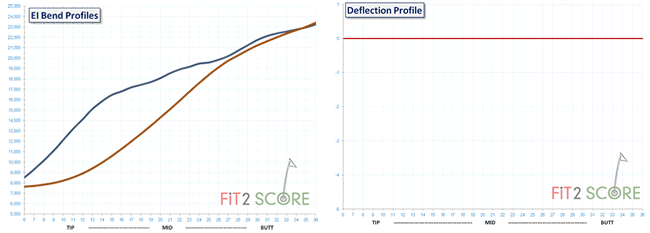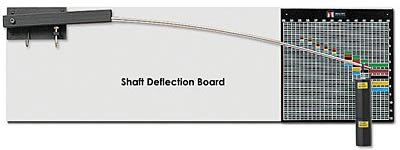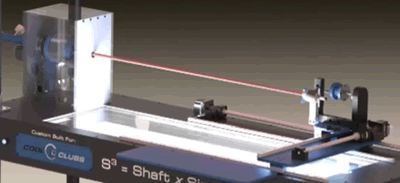Understanding the differences in golf shafts has never been easy. Bending is the product of the elastic modulus E and the area moment of inertia I of the beam cross section at a point on the beam.
 The formula looks like this, w is the bending of the beam, x is the location and k is the curvature. This is the fundamental science used by all golf shaft designers of significance. It makes simple sense to use the same system to understand their designs.
The formula looks like this, w is the bending of the beam, x is the location and k is the curvature. This is the fundamental science used by all golf shaft designers of significance. It makes simple sense to use the same system to understand their designs.
Working with my friend, Dave Tutelman, I added deflection modeling to my shaft knowledge base. I came to the realization that deflection can be calculated from EI. Knowing the EI of 36 sections of a driver shaft, a composite bend can be modeled with weight as a variable. This illustrations shows the EI profile of two shafts on the left. On the right the shafts are loaded with different weights illustrating how they bend.

I picked these two shafts to illustrate the value of knowing the EI profile of golf shafts. These two shafts are both rated by their respective manufacturers as S flex. The EI profile shows the butt and tip stiffness to be about the same. And yet, they show very different bend patterns when loaded as you can see in the deflection graphic.
 The deflection profile illustration is what you would see if you used a deflection board. I borrowed this image of a deflection board from GolfWorks. This is a classic tool used by club makers to understand shaft bending properties and stiffness.
The deflection profile illustration is what you would see if you used a deflection board. I borrowed this image of a deflection board from GolfWorks. This is a classic tool used by club makers to understand shaft bending properties and stiffness.
Frequency instruments are used in many club making shops. Frequency gauges give the club maker a number which many software systems translate into a stiffness rating. What is not seen on frequency instruments is the bend profile seen on a deflection board. The shortcoming of deflection boards is that they do not quantify the bend profile, leaving the club maker to compare bend properties with tracings. The shortcoming of frequency instruments is that the measured stiffness is at the end of the clamp and does not reflect the mid and tip stiffness of the shaft.
An updated version of the deflection board is shown here. Optical image processing can now take those bend profiles into a digital format. Once converted to a digital format they can be put to more use than the visual image that club makes used in the past.
However, extracting the sectional bend profiles from a simple overall measurement is a difficult mathematical procedure. Both frequency and overall measurement systems instead provide accumulated stiffness profiles. The profiles from these processes show the composite bend of the shaft. That system, while useful, does not show the sectional makeup of the shaft which i find is important in the feel of loading by the golfer.
Using EI values along the shaft, the overall deflection profile can be calculated and quantified as shown in the animated illustration above. This lets shaft engineers translate the matrix of materials, wall thickness, wall diameter and taper rate into computer simulated bend properties of a golf shaft. All major shaft design companies have created software to model their ideas before they develop prototype shafts.
My EI instrument measures and quantifies golf shafts. The club fitter, equipped with EI measurements, understands the bend properties of the shafts he fit with. That understanding is why it was necessary to invent and manufacture an instrument and system for measuring golf shafts. Knowing the golf shaft, a fitter understands how a particular shaft effects swing and ball flight. They can see the cause of ball flight. Without knowing the shaft, the fitter is using trial and error while observing ball flight. I call that fitting for effect. The best fitters work on the causal relationship to effect.
The load applied during a golf swing is transformed into shaft deflection. That deflection is what you feel as stiffness when you swing. Feel feedback helps you time your swing. Sectional beam EI bend profile determines not only the amount of deflection but also the shape of the deflection. And that shape influences how your swing/shaft interaction presents the club head to the ball at impact.


